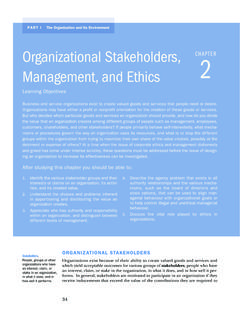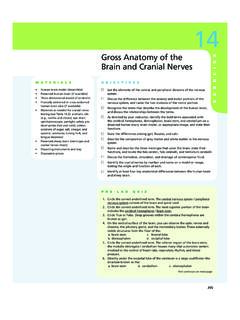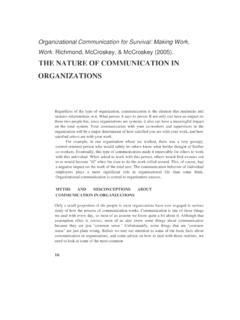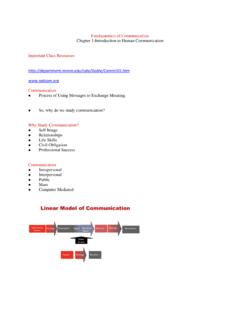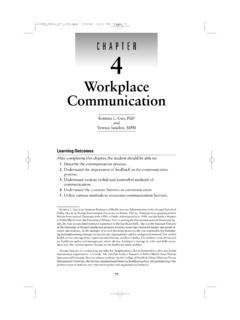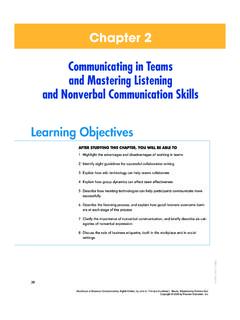Transcription of eleventh edition Communicating in Small Groups - Pearson
1 eleventh editionCommunicating in Small GroupsSteven A. BeebeTexas State UniversityJohn T. MastersonTexas Lutheran UniversityBoston Columbus Indianapolis New York San Francisco Upper Saddle RiverAmsterdam Cape Town Dubai London Madrid Milan Munich Paris Montreal TorontoDelhi Mexico City S o Paulo Sydney Hong Kong Seoul Singapore Taipei TokyoPrinciples and 115/02/14 1:32 PMdedicated to Sue and nancyEditor in Chief: Ashley DodgeSenior Acquisitions Editor: Melissa MashburnEditorial Assistant: Courtney TurcotteMarketing Coordinator: Jessica WarrenManaging Editor: Denise ForlowProgram Manager: Reena DalalSenior Operations Supervisor: Mary FischerOperations Specialist: Mary Ann GloriandeArt Director: Jayne ConteCover Designer: Bruce KenselaarCover Image: ShutterstockDirector of Digital Media: Brian HylandDigital Media Project Management: Learning Mate Solutions, CohenDigital Media Project Manager.
2 Tina GagliostroFull-Service Project Management and Composition: IntegraPrinter/Binder: Courier KendallvilleText Font: Utopia StdCopyright 2015, 2012, 2009, 2006 by Pearson Education, rights reserved. No part of this publication may be reproduced, stored in a retrieval system, or transmitted, in any form or by any means, electronic, mechanical, photocopying, recording, or otherwise, without the prior written permission of the publisher. Printed in the United States. To obtain permission to use material from this work, please submit a written request to Pearson Education, Inc., Permissions Department, 501 Boylston Street, Suite 900, Boston, MA 02116, fax: (617) 671-2290. For information regarding permissions, call (617) 671-2295 or e-mail: of Congress Cataloging-in-Publication Data unavailable at time of 2 3 4 5 6 7 8 9 10 DOJC 13 12 11 10 ISBN-13: 978-0-205-98083-3 ISBN-10: 215/02/14 1:32 PMdedicated to Sue and 315/02/14 1:32 415/02/14 1.
3 32 PMvBrief ContentSChApTer 1 Introducing group Principles and Practices 1 ChApTer 2 Understanding Small group communication Theory 36 ChApTer 3 Facilitating group Development 55 Preface xviiAcknowledgments xxiiPart I foundations of group communication ChApTer 4 Preparing to Collaborate 76 ChApTer 5 Relating to Others in Groups 102 ChApTer 6 Improving group Climate 129 ChApTer 7 Enhancing communication Skills in Groups 148 ChApTer 8 Managing Conflict 178 Part II Managing group relationships ChApTer 9 Leading Groups 218 ChApTer 10 Making Decisions and Solving Problems 240 ChApTer 11 Using Problem-Solving Techniques 269 ChApTer 12 Enhancing Creativity in Groups and Teams 301 Appendix A Principles and Practices for Effective Meetings 326 Appendix B Principles and Practices for Communicating to an Audience 337 Glossary 343 Notes 349 Photo Credits 375 Index 377 Part III Managing group tasks 515/02/14 1:32 615/02/14 1:32 PMviiContentSChApTer 1 Introducing group Principles and Practices 1 What Is Small group communication ?
4 3 communication 3A Small group of People 5 Meeting with a Common Purpose 5 Feeling a Sense of Belonging 5 Exerting Influence 5 What Is Team communication ? 6 Characteristics of an Effective Team 8 Characteristics of Effective Team Members 10puTTing prinCipleS inTo prACTiCe: Strategies for Becoming a Competent Team Member 12 Communicating Collaboratively: Advantages and Disadvantages 13 Advantages 13 Disadvantages 14 When Not to Collaborate 16Me Versus We 17 Communicating in Different Types of Groups 19 Primary Groups 19 Secondary Groups 20 Communicating in Virtual Groups and Teams 21 Channels of Virtual Collaboration 22 Differences Between Virtual and Non-Virtual Collaboration 23 Virtual group and Team Theory 25 How Can You Become a Competent Small group Communicator? 26 VirTuAl Groups 27 The Essence of communication Competence 28 The Nine Core Small group communication Competencies 28 CASe STudy: The Battle over Working as a Virtual group 29 CollABorATing eThiCAlly: What Would you do?
5 31 STudy guide review, Apply, and Assess group communication principles and practices 32 ChApTer 2 Understanding Small group communication Theory 36 The Nature of Theory and the Theory-Building Process 37 Theory: A Practical Approach to group communication 38 Explanatory Function 39 Preface xviiAcknowledgments xxiiPart I foundations of group 715/02/14 1:32 PMContentsviiiPredictive Function 39 CollABorATing eThiCAlly: What Would you do? 39 The Purpose of communication in Small Groups : Making Sense 40 Complexity 41 Small Groups : More Complexity 41 Theoretical Perspectives for the Study of group communication 42 Systems Theory 42 Social Exchange Theory 43 Symbolic Convergence Theory 44 CASe STudy: how do you Keep a group on Task? 46 Structuration Theory 46 Functional Theory 47puTTing prinCipleS inTo prACTiCe: Structuration and the exercise of Free Will 48A Model of Small group communication 49 VirTuAl Groups 50 STudy guide review, Apply, and Assess group communication principles and practices 52 ChApTer 3 Facilitating group Development 55 Why People Join Groups 56 Interpersonal Needs 56 Maslow s Theory 56 Schutz s Theory 57 Individual and group Goals 59 Establishing Mutuality of Concern 60 CollABorATing eThiCAlly: What Would you do?
6 62 Interpersonal Attraction 62 Similarity 63 Complementarity 63 Proximity, Contact, and Interaction 63 Physical Attractiveness 63puTTing prinCipleS inTo prACTiCe: Mutuality of Concern 64 group Attraction 64 group Activities 64 group Goals 65 VirTuAl Groups 65 group Membership 66 Culture and group Development 66 Individualism and Collectivism 67 High-Context and Low-Context Cultures 67 High-Contact and Low-Contact Cultures 68 Homogeneity and Diversity 69 group Formation over Time 70 CASe STudy: how do you Manage Conflicting needs and goals? 71 STudy guide review, Apply, and Assess group communication principles and practices 815/02/14 1:32 PMContentsixChApTer 4 Preparing to Collaborate 76 How to Develop a Discussion Plan 77 Get Acquainted with Your group Members 78 Clarify the Goals of the group 78 Develop a Plan for Gathering Information and Analyzing Issues 79 Follow a Structured Agenda to Accomplish the Task 80 Share Information with Others 81 Determine How to Present Your Information 82puTTing prinCipleS inTo prACTiCe: What Should you do with group Members Who don t pull Their Weight?
7 82 How to Formulate Discussion Questions 84 Questions of Fact 85 VirTuAl Groups 85 Questions of Prediction 86 Questions of Value 87 Questions of Policy 88 CASe STudy: Questioning the Cost of Textbooks 89 How to Use Logic and Reasoning Effectively 90 Inductive Reasoning 90 Deductive Reasoning 91 Causal Reasoning 92 How to Evaluate Evidence in group Discussions 92 Facts 92 Examples 93 Opinions 93 Statistics 93 Gathering and Evaluating Evidence: A Special Emphasis on Web Resources 94 How to Develop Critical-Analysis Skills 95 Causal Fallacy 95 Either/Or Fallacy 95 Bandwagon Fallacy 95 Hasty Generalization 96 Attacking the Person 96 Red Herring 96 CollABorATing eThiCAlly: What Would you do? 97 STudy guide review, Apply, and Assess group communication principles and practices 98 ChApTer 5 Relating to Others in Groups 102 Roles 103 Who Are You? 103 Self-Concept Development: Gender, Sexual Orientation, Culture, and Role 104 Diversity of Roles in Small Groups 105 group Task Roles 106 Part II Managing group 915/02/14 1:32 PMContentsxGroup-Building and Maintenance Roles 106 Individual Roles 107 Norms 108 How Do Norms Develop?
8 109 Identifying group Norms 109puTTing prinCipleS inTo prACTiCe: establishing group norms 110 Conforming to group Norms 110 CollABorATing eThiCAlly: What Would you do? 112 Establishing Ground Rules 112 Status 114 Privileges Accorded to High-Status group Members 114 Effects of Status Differences 114 Status Differences in Online Groups 115 Observing Status Differences to Predict group Dynamics 116 Power 116 Power Bases 116 VirTuAl Groups 117 Effects of Power on group Process 118 Power and Gender 119 Status and Power: A Cultural Footnote 119 Trust 120 Developing Trusting Relationships 120 Trust in Face-to-Face and Virtual Teams 121 The Development of group Relationships over Time 121 CASe STudy: Adjusting to Variable Status and power 122 Gender and communication 122 Culture 123 Conversational Style 124 Time 124 STudy guide review, Apply, and Assess group communication principles and practices 126 ChApTer 6 Improving group Climate 129 Defensive and Supportive Climates 130 Evaluation versus Description 131 Control versus Problem Orientation 131 Strategy versus Spontaneity 131 Neutrality versus Empathy 132 Superiority versus Equality 132 Certainty versus Provisionalism 132 Interpersonal Confirmation and Disconfirmation 133 CollABorATing eThiCAlly: What Would you do?
9 134 Disconfirming Responses 134 Confirming Responses 135 group Cohesiveness 136 Composition and Cohesiveness: Building a Team 1015/02/14 1:32 PMContentsxiIndividual Benefits and Cohesiveness 137 Task Effectiveness and Cohesiveness 137 communication and Cohesiveness 137 Cohesiveness in Virtual Teams 138 communication Networks 138puTTing prinCipleS inTo prACTiCe: Cohesiveness and productivity at harley-davidson 139 group Size 140 group Climate and Productivity 141 VirTuAl Groups 141 CASe STudy: Avoiding defensiveness 143 STudy guide review, Apply, and Assess group communication principles and practices 145 ChApTer 7 Enhancing communication Skills in Groups 148 Verbal Dynamics in Small Groups 149 Words as Barriers to communication 149 Listening 151 Listening Styles 151 Obstacles to Effective Listening 152A Guide to Active Listening 154 The Importance of nonverbal communication in Groups 155 More Time Is Spent Communicating Nonverbally Than Verbally 156 Emotions and Feelings Are Typically Expressed Nonverbally Rather Than Verbally 156 nonverbal Messages Are Usually More Believable Than Verbal Messages 156 Applications of nonverbal communication Research to Groups 157 Posture, Movement, and Gestures 157 Eye Contact 158 Facial Expressions 160 Vocal Cues 160 Personal Space 161 Territoriality 162 Seating Arrangement 162 Personal Appearance 164 communication Environment 165puTTing prinCipleS inTo prACTiCe.
10 Improving nonverbal communication Skills 166 Functions of nonverbal Cues in Groups 167 nonverbal Messages Influence Perceived Leadership 167 nonverbal Messages Influence Persuasion Skills 167 nonverbal Messages Help Synchronize Interaction 167 nonverbal Messages Provide Information about Perceived Honesty or Dishonesty 168 Interpreting nonverbal communication 169 VirTuAl Groups : nonverbal Virtual communication 1115/02/14 1:32 PMContentsxiiCollABorATing eThiCAlly: What Would you do? 171 CASe STudy: interpreting indirect communication 172 STudy guide review, Apply, and Assess group communication principles and practices 174 ChApTer 8 Managing Conflict 178 What Is Conflict? 180 Causes of Conflict 180 Misconceptions about Conflict 181 Types of Conflict 182 Pseudo-Conflict: When People Misunderstand One Another 182 Simple Conflict: When People Disagree about Issues 183 Ego Conflict: When Personalities Clash 184 Conflict and Diversity in Small Groups 186 Conflict in Individualistic and Collectivistic Cultures 186 Conflict in High-Context and Low-Context Cultures 186puTTing prinCipleS inTo prACTiCe: Strategies for Managing Conflict in diverse Groups : Surface and deep diversity 187 Approaches to Conflict When There Are Gender Differences 188 Conflict-Management Styles 188 Avoidance 189 Accommodation 189 Competition 190 Compromise 191 Collaboration 191 Collaborative Conflict Management.

